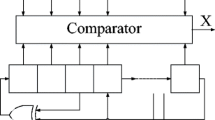Abstract
As digital signal processing systems become larger and clock rates increase, the typical design approach using global clock synchronization will become increasingly difficult. The application of asynchronous clock-free designs to high-performance digital signal processing systems is one promising approach to alleviating this problem. To demonstrate this approach for a typical signal processing task, the system architecture and circuit design of a chip set for implementing high-rate adaptive lattice filters using the asynchronous design techniques is presented.
Similar content being viewed by others
References
S.Y. Kung and R.J. Gal-Ezer, “Synchronous versus Asynchronous Computation in Very Large Scale Integration Array Processors,”SPIE, Real Time Signal Processing V, 341, 1982.
M. Hatamian and G.L. Cash, “Parallel Bit-Level Pipelined VLSI Designs for High-Speed Signal Processing,”Proceedings of the IEEE, vol. 75, 1987, pp. 1192–1202.
D.F. Wann and M.A. Franklin, “Asynchronous and Clocked Control Structures for VLSI Based Interconnection Network,”IEEE Trans. on Computers, vol. 32, 1983.
W.A. Clark, “Macromodular Computer Systems,”Proc. 1967 Spring Jt. Comp. Conf., pp. 335–336 Thompson Book Co., 1967.
R.J. Swan, S.H. Fuller, and D.P. Siewiorek, “Cm*—A Modular Multiprocessor,”Proc. AFIPS 1977 Nat. Comput. Conf., 1977, pp. 637–644.
T.E. Williams, M. Horowitz, R.L. Alverson, and T.S. Yang, “A Self-Timed Chip for Division,”Advanced Research in VLSI, Proc. of 1987 Stanford Conference, March 1987, pp. 75–96.
S.E. Schuster, et al., “A 15 ns CMOS 64K RAM,”Proc. ISSCC 1986, Feb. 1986, pp. 206–207.
C. Mead and L. Conway,Introduction to VLSI Systems, Chap. 7, Reading, MA: Addison-Wesley, 1980.
D.M. Chapiro, “Globally-Asynchronous Locally-Synchronous System,”Ph.D. Thesis, (STAN-CS-1026) Stanford University, Oct. 1986.
S.Y. Kung, K.S. Arum, R.J. Gal-Ezer, and D.V. BhaskarRao, “Wavefront Array Processor: Language, Architecture, and Applications,”IEEE Trans. on Computers, vol. 31, 1982, p. 1054.
K.C. Saraswat and F. Mohammadi, “Effect of Scaling of Interconnections on the Time Delay of VLSI Circuits,”IEEE Journal of Solid State Circuits, vol. 17, 1982.
G.M. Jacobs and R.W. Brodersen, “Self-Timed Integrated Circuits for Digital Signal Processing Applications,”VLSI Signal Processing III, New York: IEEE Press, 1988.
T.H.-Y. Meng and D.G. Messerschmitt, “Arbitrarily High Sampling Rate Adaptive Filters,”IEEE Trans. on ASSP, vol. 35, 1987.
M.J. Shensa, “Recursive Least-Squares Lattice Algorithms: A Geometrical Approach,”IEEE Trans. Automatic Control, vol. 26, 1981, pp. 695–702.
H.-H. Lu, E.A. Lee, and D.G. Messerschmitt, “Fast Recursive Filtering with Multiple Slow Processing Elements,”IEEE Trans. on CAS, vol. 32, 1985.
M. Renfors and Y. Neuvo, “The Maximum Sampling Rate of Digital Filters Under Hardware Speed Constraints,”Proc.Trans. on CAS, vol. 28, 1981.
C.H. van Berkel and R.W. Saeijs, “Compilation of communicating processes into delay-insensitive circuits,”Proc. of ICCD 1988, October.
R.E. Miller,Switching Theory, New York: John Wiley, 1965.
T.H.-Y. Meng, R.W. Brodersen, and D.G. Messerschmitt, “Automatic Synthesis of Asynchronous Circuits from High Level Specifications,”IEEE Trans. on CAD, vol. 8, 1989.
D.B. Armstrong, A.D. Friedman, and P.R. Manon, “Design of Asynchronous Circuits Assuming Unbounded Gate Delays,”IEEE Trans. on Computers, vol. 18, 1969.
T.H.-Y. Meng, G.W. Jacobs, R.W. Brodersen, and D.G. Messerschmitt, “Asynchronous Processor Design for Digital Signal Processing,”Proc. IEEE ICASSP 1988, April.
A.J. Martin, “Compiling Communicating Processes into Delay-Insensitive VLSI Circuits,”Distributed Computing, 1986, pp. 226–234.
W.-L. Chen,Private Communications, 1987.
A.D. Booth, “A Signed Binary Multiplication Technique,”Q.J. Mech. Appl. Math., vol. 4, 1951, pp. 236–240.
M. Santoro and M. Horowitz, “A Pipelined Iterative Array Multiplier,”IEEE ISSCC 88 Digest of Technical Papers, February 1988.
M. Horowitz,IRSIM User's Manual, Stanford University, 1988.
K.K. Parhi, “Pipelined VLSI Recursive Filter Architectures Using Scattered Look-Ahead and Decomposition,”Proceedings of ICASSP 1988, April.
K.K. Parhi and M. Hatamian, “A High-Sampling Rate Recursive Digital Filter Chip,”VLSI Signal Processing III, New York: IEEE Press, 1988.
Author information
Authors and Affiliations
Additional information
This research was sponsored in part by the Semiconductor Research Corporation and by DARPA.
Rights and permissions
About this article
Cite this article
Meng, T.H.Y., Brodersen, R.W. & Messerschmitt, D.G. A clock-free chip set for high-sampling rate adaptive filters. J VLSI Sign Process Syst Sign Image Video Technol 1, 345–365 (1990). https://doi.org/10.1007/BF00929927
Received:
Revised:
Published:
Issue Date:
DOI: https://doi.org/10.1007/BF00929927




